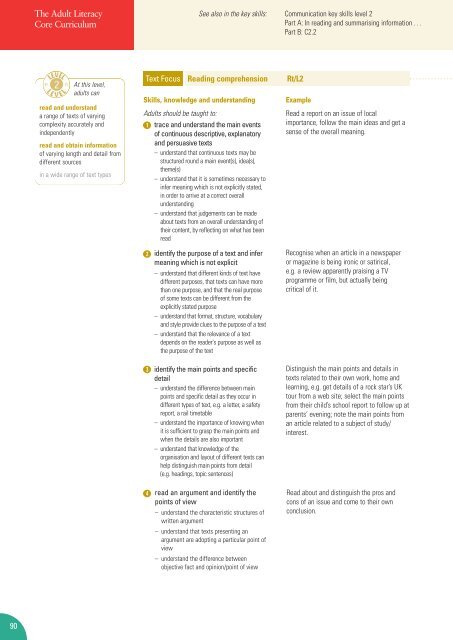Adult Literacy Core Curriculum - Nationally developed Skills for Life ...
Adult Literacy Core Curriculum - Nationally developed Skills for Life ...
Adult Literacy Core Curriculum - Nationally developed Skills for Life ...
Create successful ePaper yourself
Turn your PDF publications into a flip-book with our unique Google optimized e-Paper software.
90<br />
The <strong>Adult</strong> <strong>Literacy</strong><br />
<strong>Core</strong> <strong>Curriculum</strong><br />
At this level,<br />
adults can<br />
read and understand<br />
a range of texts of varying<br />
complexity accurately and<br />
independently<br />
read and obtain in<strong>for</strong>mation<br />
of varying length and detail from<br />
different sources<br />
in a wide range of text types<br />
Text Focus Reading comprehension Rt/L2<br />
<strong>Skills</strong>, knowledge and understanding<br />
<strong>Adult</strong>s should be taught to:<br />
1 trace and understand the main events<br />
of continuous descriptive, explanatory<br />
and persuasive texts<br />
– understand that continuous texts may be<br />
structured round a main event(s), idea(s),<br />
theme(s)<br />
– understand that it is sometimes necessary to<br />
infer meaning which is not explicitly stated,<br />
in order to arrive at a correct overall<br />
understanding<br />
– understand that judgements can be made<br />
about texts from an overall understanding of<br />
their content, by reflecting on what has been<br />
read<br />
2<br />
3<br />
4<br />
See also in the key skills: Communication key skills level 2<br />
Part A: In reading and summarising in<strong>for</strong>mation . . .<br />
Part B: C2.2<br />
identify the purpose of a text and infer<br />
meaning which is not explicit<br />
– understand that different kinds of text have<br />
different purposes, that texts can have more<br />
than one purpose, and that the real purpose<br />
of some texts can be different from the<br />
explicitly stated purpose<br />
– understand that <strong>for</strong>mat, structure, vocabulary<br />
and style provide clues to the purpose of a text<br />
– understand that the relevance of a text<br />
depends on the reader's purpose as well as<br />
the purpose of the text<br />
identify the main points and specific<br />
detail<br />
– understand the difference between main<br />
points and specific detail as they occur in<br />
different types of text, e.g. a letter, a safety<br />
report, a rail timetable<br />
– understand the importance of knowing when<br />
it is sufficient to grasp the main points and<br />
when the details are also important<br />
– understand that knowledge of the<br />
organisation and layout of different texts can<br />
help distinguish main points from detail<br />
(e.g. headings, topic sentences)<br />
read an argument and identify the<br />
points of view<br />
– understand the characteristic structures of<br />
written argument<br />
– understand that texts presenting an<br />
argument are adopting a particular point of<br />
view<br />
– understand the difference between<br />
objective fact and opinion/point of view<br />
Example<br />
Read a report on an issue of local<br />
importance, follow the main ideas and get a<br />
sense of the overall meaning.<br />
Recognise when an article in a newspaper<br />
or magazine is being ironic or satirical,<br />
e.g. a review apparently praising a TV<br />
programme or film, but actually being<br />
critical of it.<br />
Distinguish the main points and details in<br />
texts related to their own work, home and<br />
learning, e.g. get details of a rock star’s UK<br />
tour from a web site; select the main points<br />
from their child’s school report to follow up at<br />
parents’ evening; note the main points from<br />
an article related to a subject of study/<br />
interest.<br />
Read about and distinguish the pros and<br />
cons of an issue and come to their own<br />
conclusion.

















